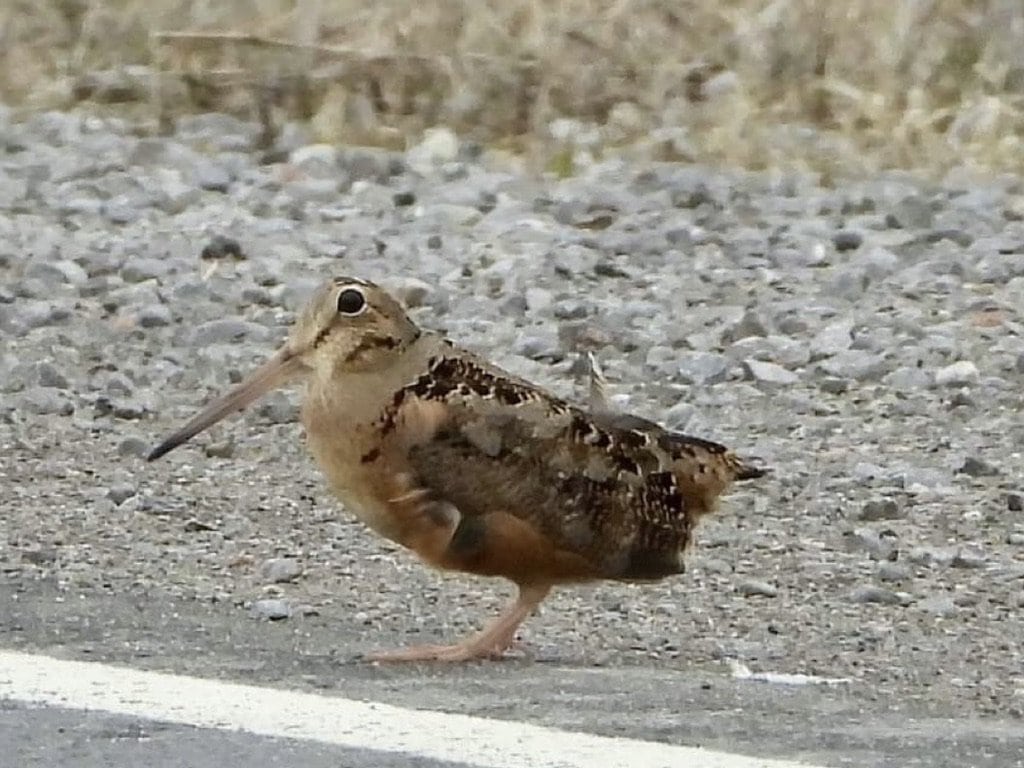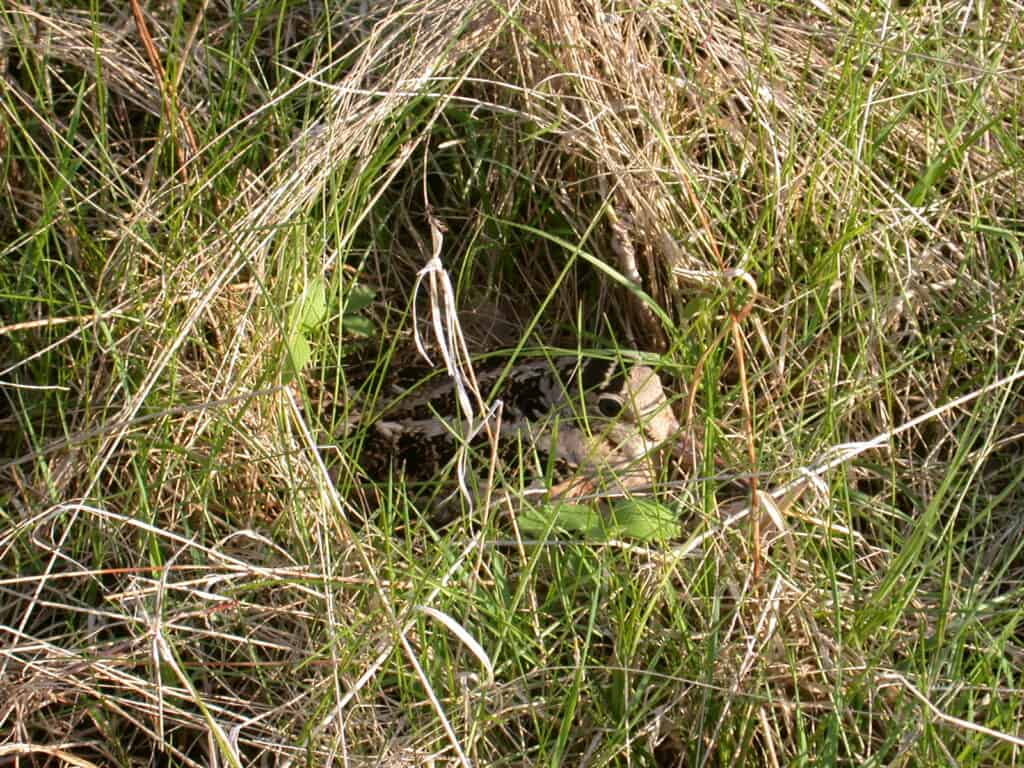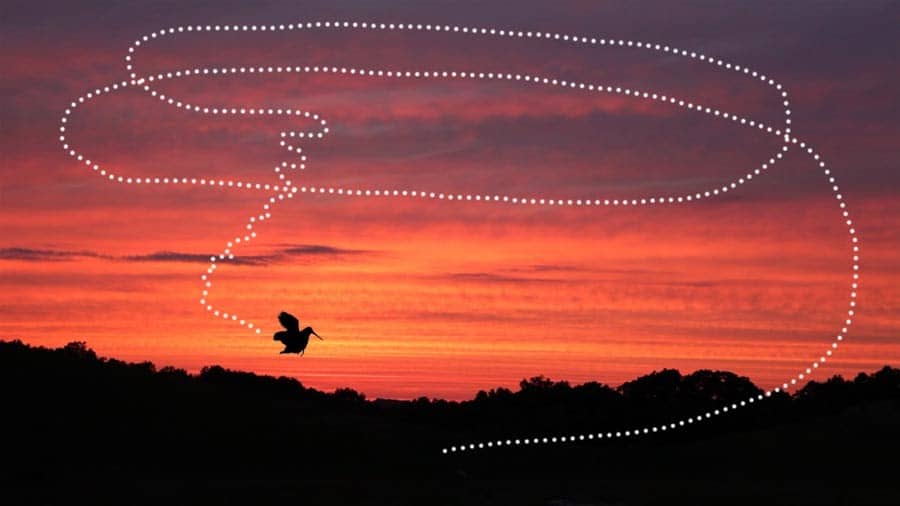Many people spend their whole life never knowing such an iconic bird exists.
Peterborough Examiner – April 12, 2024 – by Drew Monkman
With monikers such as pop-eyed shot dodger, bogsucker, sky dancer and timberdoodle, the American woodcock may have the most evocative nicknames of any bird. However, the real claim to fame of this curious shorebird species is its spring courtship flight or “sky dance”. Males fly high overhead on twittering wings before returning abruptly to the ground where they resume their unique “peenting” calls.
The famous American conservationist Aldo Leopold, author of the natural history classic “A Sound County Almanac”, wrote eloquently about the woodcock. “Up and up he goes, the spirals steeper and smaller, the twittering louder and louder, until the performer is only a speck in the sky. Then, without warning, he tumbles like a crippled plane, giving voice in a soft liquid warble that a March bluebird might envy.”
Although this species can be found all over the Kawarthas, many people spend their whole life never knowing such a bird exists. What a shame this is, because the sight and sound of a displaying woodcock is a true spectacle of spring.

A bird unlike any other
Woodcock arrive back in late March from wintering grounds in the southeastern U.S. Their arrival more or less coincides with the thawing of the soil, which frees up their favourite food – earthworms. Migrating birds will sometimes show up in suburban backyards and create quite a stir as people try to figure out the identity of the rather ridiculous-looking visitor.
The woodcock is similar in size and shape to a fat European starling, but with a mottled colouration of blacks, browns, tans and whites. This provides near-perfect camouflage against the dead leaves and twigs of the forest floor. Evolution has also provided the woodcock with very large eyes, located high and well back on the head. The size and placement allows the bird to see in front, behind and even above, affording a view of approaching predators such as domestic cats, hawks, owls and coyotes. This adaptation is extremely important because woodcocks spend a lot of time with their head down and their bill deep in the mud.
Like many shorebirds, the woodcock also has a long bill – the length of your middle finger – with which it probes deeply into soil for earthworms. The sensitive, flexible bill tip can feel a worm in its underground burrow and then open to grab it.
The woodcock’s walking style is also quite different from other birds. It tends to amble slowly along, all the while rocking its body back and forth. Its head, however, remains motionless. This strange gait is accompanied by a kind of foot-stomping, which is thought to cause worms to move around in the soil, thereby making them more easily detectable.

Sky dance
From late March until early June, the male performs one of the most fascinating courtship spectacles in nature, in which he goes to extraordinary lengths to show his fitness and virility to females. The sky dance is performed over openings known as singing grounds. Beginning in the near-dark evening twilight, the male starts to “peent.” The sound is reminiscent of a buzzy, nasal toy horn. As darkness falls, the peents become more numerous until all of a sudden the bird bursts into the air and flies upwards in wide circles.
Because the woodcock’s three outer wing feathers are stiff, narrow and spread apart during flight, the air rushing through causes them to vibrate, producing a high, mechanical, twittering sound. After reaching a height of about 100 metres, the twittering becomes intermittent, and the bird soon begins a zigzag descent. A third sound is then produced as the woodcock starts singing liquid, kissing notes – just in case the flight itself was not enough to impress the hard-to-please female! The kissing notes grow louder and louder as he approaches the ground, but then cease completely for the final portion of the descent.
The bird usually lands almost at the same spot from whence he took off. He then walks stiff-legged in the direction of the nearby female, wings stretched vertically. Soon after, he begins peenting once again. A few minutes later, the poor bird—probably close to exhaustion — launches into yet another flight. Woodcock will display for up to an hour at dusk and dawn and even through the night if there is a full moon.
The male will mate with any female impressed with his display. However, there is a catch. He provides no help with nest-building or with brood rearing, but simply turns his attention to attracting other females. All of the woodcock’s various sounds can be heard by visiting allaboutbirds.org. To see and hear a great video of the aerial display, click on this link https://rb.gy/bs8e7j or go to YouTube and search for “American Woodcock Air Dance”.

Where to find them
American woodcock are birds of habitats that are in transition, such as abandoned farmlands reverting to forest. They also frequent second-growth forest edges and low, damp, brushy fields. One place to see them is the Trent Wildlife Sanctuary on University Road, often quite close to the parking lot. Listen carefully for the peenting sound. Other locations worth trying include the Camp Kawartha Environment Centre on Pioneer Road, the Harold Town Conservation Area on the Old Norwood Road, and the Lakefield Sewage Lagoons on County Road 33. If you go to ebird.org and click on Explore, you can find numerous other locations, as well.
Because the darkening sky makes it difficult to actually see the woodcock in flight, try to face west. In this way, the bird will stand out against the lighter western sky. After it takes flight, you can move a little closer to the take-off point. By remaining quiet and staying low, it is often possible to end up close to the bird when it lands.
Woodcock also garner attention in the fall because they are one of the few shorebirds that is hunted for sport. They often flush right from under your feet and fly at “jet-propelled speeds on a corkscrew trajectory” as local outdoor writer Jack Davis once wrote.
So, what is the value of this odd bird? For the nature enthusiast, the woodcock’s amazing behaviours prompt fascination and sheer aesthetic enjoyment; for the more scientifically-inclined, the bird’s many adaptations exemplify the power and wonder of evolution; and for hunters, the bird represents not only a delicious meal but also the pleasure of being out on a crisp autumn day and shooting such a challenging target.
This multiplicity of values is true about nature as a whole. As Yale scholar and environmentalist Stephen Kellert writes, “when viewed from any single value, the woodcock (or any other species) can be easily marginalized and rendered irrelevant… Yet, when seen in a broader spectrum of relationships…this bird becomes another portal for deepening our sense of selfhood and membership in a broader community, enriching both our personal and collective lives.”
Bio-blitz and Nature Challenge 2024
On April 26 and 27, the City of Peterborough is once again hosting a community bio-blitz to record the diversity and abundance of local wildlife in Ecology Park and nearby Beavermead and Farmcrest Parks. Anyone can participate. Meet at Ecology Park from 11 a.m. to 3 p.m. to help identify local wildlife with the help of members of the Peterborough Field Naturalists. Guided nature walks and children’s activities are planned. To assist with recording observations, the iNaturalist app will be used to upload species sightings to a unique Peterborough project event page. Before arriving, download the app to your mobile device.
The bio-blitz is part of the four-day City Nature Challenge which takes place from Friday, April 26 to Monday, April 29 and is open to all city residents. Sightings from anywhere in the city are welcome but most be recorded on iNaturalist. This is a global competition of nature sightings in communities from around the world. For more information, go to Peterborough.ca.